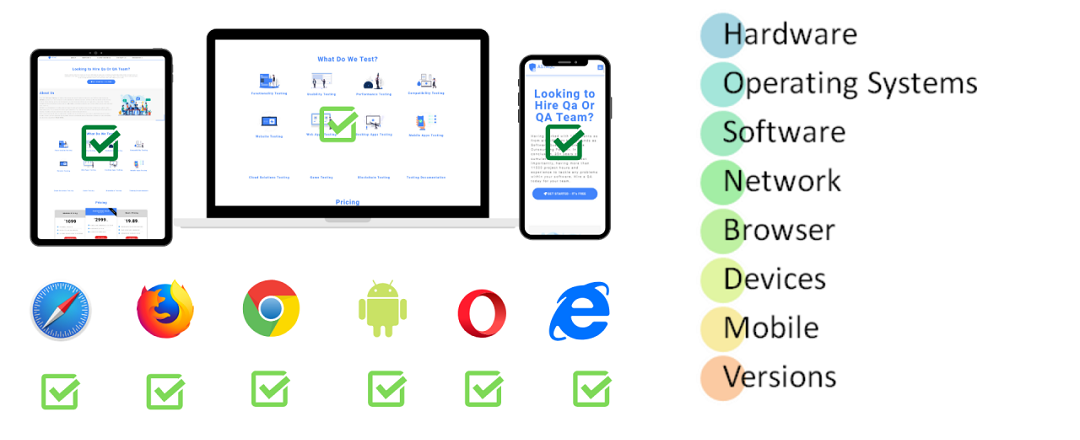
Compatibility Testing
With SSAK software testing services, you can explore the potential of compatibility testing, where an application is painstakingly evaluated across a variety of browsers, databases, hardware, operating systems, server infrastructures, resolution displays, and devices.
Compatibility is nothing but the capability of existing or living together. In normal life, Oil is not compatible with water, but milk can be easily combined with water.
Compatibility Testing is a type of Software testing to check whether your software is capable of running on different hardware, operating systems, applications, network environments or Mobile devices.
A compatibility test is an assessment used to ensure a software application is properly working across different browsers, databases, operating systems (OS), mobile devices, networks and hardware
Compatibility testing helps ensure complete customer satisfaction as it checks whether the application performs or operates as expected for all the intended users across multiple platforms.
The drug-excipient compatibility studies are carried out with an intent to identify, quantify and predict potential interactions (physical or chemical) along with the impact of these interactions on the manufacturability, quality and performance of the final drug product.
If two substances can mix together and undergo a chemical reaction, they are considered compatible.
Excipient compatibility studies are conducted with the primary goal of selecting dosage form components that are compatible with the drug. Methodically conducted experiments also provide additional information on stability profile of the drug, identify degradation products and mechanisms.
Excipients can initiate, propagate or participate in chemical or physical interactions with an active substance, possibly leading to compromised quality or performance of the medication.
Once the application is stable, we moved it to the production, it may be used or accessed by multiple users on the different platforms, and they may face some compatibility issues, to avoid these issues, we do one round of compatibility testing.
Compatibility testing is a form of non-functional software testing -- meaning it tests aspects such as usability, reliability and performance -- that is used to ensure trustworthy applications and customer satisfaction. Compatibility tests are crucial to the successful performance of applications.
Compatibility Testing is a type of Non-functional testing
Backward Compatibility Testing is a technique to verify the behavior and compatibility of the developed hardware or software with their older versions of the hardware or software. Backward compatibility testing is much predictable as all the changes from the previous versions are known.
Forward Compatibility Testing is a process to verify the behavior and compatibility of the developed hardware or software with the newer versions of the hardware or software. Forward compatibility testing is a bit hard to predict as the changes that will be made in the newer versions are not known.
Compatibility testing is non-functional testing. It is carried out to verify whether an application or software can run on different devices, browsers, operating systems, hardware, and networks.
It is mainly aimed at giving a quality customer experience. If any customer is facing an issue due to the application’s incompatibility. It may have a negative impact on the customer. S/he might abandon the application/website. This testing ensures that the application works on all the possible combinations of devices, browsers, OS, etc. as desired.
It reduces future customer support required for the LIVE application. Whenever any customer faces issues because of the incompatibility of the application. S/he is likely to call customer service.
But if the application has been tested in advance. And, these issues were identified and solved before passing the application for customer use, this unnecessary cost of customer service can be avoided.
Apart from the reduced cost of customer service, it also helps in attracting and retaining more customers as it is directly connected to giving customer satisfaction, which helps in increasing an organization’s revenue.
Compatibility testing requires thoughtful planning, as it requires setting up multiple platforms, browsers, operating systems, devices, network configurations, and hardware configurations.
Before starting compatibility testing, a testing team needs to make sure the application is ready to test with the complete development of all the important features.
After that, they need to make a list of all the platforms, devices, browsers, operating systems, etc. on which an application or software is likely to be used or with which an application or software is likely to interact. Testers should also have adequate knowledge of these platforms and devices that will be used for testing.
The next step is to set up an environment with all these platforms, browsers, devices, etc., and to test an application or software.
After testing, all the bugs will be reported and after review, they will be sent to the development team for fixing.
Once bugs have been fixed, they will go to the testing team for defect verification.
